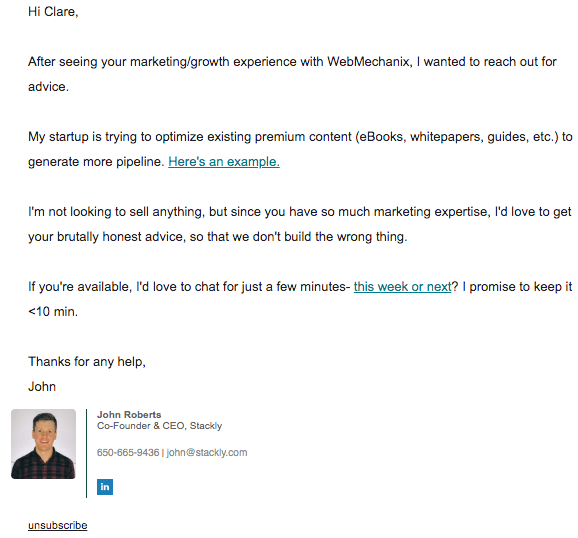
How to Build the Best B2B Email Marketing Campaigns (With Examples)
The three musketeers essential campaigns
If you’re in the B2B (business-to-business) or SaaS (software-as-a-service) business, marketing automation isn’t just a trinket or an overrated trend—it’s critical to your success.
When considering SaaS or B2B email marketing strategy, you should have these three types of multi-part, ongoing campaigns at a minimum:
- Consideration
- Onboarding
- Re-engagement (also called win back)
All three parts are vital for creating the best B2B email marketing campaigns. All of them have some overlap, and they can be applied not only to leads but also to customers. Email and marketing automation are compelling when executed well to nurture prospects.
Nurtured leads spend 47% more than non-nurtured leads.*
Without further ado, let’s take a look at B2B email marketing best practices for each of the campaign:
1) Consideration
At the top of the trusty ol’ marketing funnel lies the consideration phase. In this stage, you’re going to be using email for retargeting leads who haven’t yet made a purchase (because they are still considering your products and services). A consideration email might guide prospects toward the next steps or give them some valuable content they might enjoy. And it doesn’t have to be fancy—it can be as simple as booking a brief intro meeting or providing a “getting started” checklist.
Guess what? Your customers are in consideration mode, too. Use email to nurture them with product and industry information that’s relevant to their needs. This nurturing should deepen your relationship and ultimately lead to up-sells, cross-sells, referrals, and even testimonials. When people like you, they want to buy from you, and all of that rolls into the consideration stage.
2) Onboarding
Concerning the onboarding phase, you need to identify anything that would help your contacts get to know you better. For both leads and customers, this content is a multi-part email series that includes some product and service information.
For leads, you’d want to welcome new folks who enrolled in a free trial, introduce them to the product, show them the best features, share how-tos, and so on. With free-trial users, the most important “next step” that they can take is to convert to a paid account. For instance, if they’re moving from a different system to yours (e.g., for CRM), show them how simple it is to import their old data, preferences, and workflows. Meanwhile, onboarding customers who’ve purchased your product will look a little different. With a new customer, you’d want them to know more specific details about account setup and who their points of contact would be for support.
Onboarding is a crucial workflow; if done right, it helps to cement your brand loyalty and build brand equity with both leads and customers. For leads, this kind of workflow is especially important because it demonstrates right from the beginning that they can expect clear, relevant communication when they become a customer. When your free-trial users see that you’re putting your best foot forward before they’re even customers, they’ll be more likely to take that next step.
3) Re-engagement
Re-engagement campaigns target leads and customers who have been inactive for some (reasonable) period. This stage is the point at which you try to convince your leads to come back, such as by promoting valuable content or offering incentives. Re-engagement campaigns are also the perfect hotbed for testing things that are a little different from your normal routine.
With customers, this can be a slippery slope. On the one hand, it’s good to stay actively engaged. There’s another school of thought that says, “If they’re paying you but aren’t using the software, why bother them?”
But you can always reach out and simply say, “Hey, we just want to check in since we haven’t heard from you for a while.” You never know how they might respond. It could simply be that they’ve experienced turnover and are now looking for your help. Or perhaps they just need a refresher on what exactly it is that you offer. Maybe you have new features that they don’t know about. You’ll never reconnect if you don’t reach out.
In the grand scheme of things, re-engagement is simply a good marketing practice. Sure, it could remind them that they’re paying for this thing and aren’t using it, which may lead them to cancel their subscription. You could avoid pointing out their inactivity, but doing so seems unethical if you’re actively tracking that metric, and it can negatively affect your company’s long-term goals. Either way, people are eventually going to catch on, so it’s probably best to approach it from the angle of a company that has the customer’s best interests in mind.
B2B email marketing examples: The good, the bad, and the ugly
So we’ve talked about the best B2B email marketing campaign types, but what constitutes a “great” marketing email? Well, it really depends on the audience, of course. Nonetheless, here are a few critiqued examples.
Hulu: unsubscribe confirmation

This one’s great. It’s an easy-to-overlook, diamond-in-the-rough email. Here’s why:
- The artwork is straightforward, clever, and easy to recognize. The TV is devastated, and the headline supports it well.
- It’s so simple and elegant. There’s plenty of whitespace, and the email utilizes color well (and consistently!) for emphasis.
- There’s a really clever bit of personalization in the copy. Hulu has movies and TV episodes, but the email only calls out “thousands of episodes of TV.” I bet the recipient of this email only (or mostly) used the service to watch television. If the email was sent to a movie junkie instead, that copy would likely read “thousands of movies.”
There’s one detractor, however, and that’s the use of “Preferences” instead of “Unsubscribe” in the footer. Sure, there are merits to not calling out an unsubscribe link and using a preference link instead, but it’s also a little deceptive. And the big internet service providers (ISPs) in particular, like Gmail, Yahoo!, etc., don’t like that. Don’t hide the unsubscribe option by making it tiny or calling it something else.
Grammarly: knowing your audience

I nabbed this one from ReallyGoodEmails a couple of years ago and kept it in my swipe file because it’s just that good.
- The subject line is, “You’ve Earned a New Badge!” But the copy clarifies that the badge is for inactivity, making it a pretty clever win-back campaign. Earning a new badge for a product you haven’t used in a while would seem confusing and increase the likelihood of opening because the recipient is wondering what’s going on.
- The copy is brilliant for the brand, relying on the wildly popular novel often read in grade school, A Wrinkle in Time.
- The clock doubles as melting time AND a ghost, subtly implying that the recipient ghosted Grammarly.
Though this email makes me giggle a little every time I see it, there’s a huge problem. The CTA needs instructions below it because it doesn’t look like a regular ol’ button. It’s also red but says “GO” on it. Don’t forget the user experience when you’re crafting your emails.
Plan emails: keeping it simple
For my plain email folks, here are a couple of examples for ya. 🙂

I got this email a while back from Strikingly, purveyor of template-based personal and professional websites. It’s succinct while managing to hit three really solid high notes.
- Although I wasn’t interested in using the feature the email promotes (LinkedIn One Click Website Builder), I was satisfied that they have such a simple offering, considering many people have little to no experience building sites.
- The offer to meet for coffee was personal and warm in a digital world (the subject line was “Coffee, maybe?”). And of course, they have logistical things to consider. They’re going to go where they have the largest concentrations of respondents. But I got this message four years ago and still thought of including it as a great example of a plain email.
- David closes with a postscript letting me know how to handle tech questions in a way that sounds genuinely helpful instead of implying that he either can’t answer them or doesn’t want to.
- They’re technically using two CTAs, but minimizing the second one ensures that the primary CTA doesn’t lose weight. So if there’s a time when it’s appropriate to use “Let us know where you are here!” instead of something like “Tell us where you live!”, it’s in an example like this.

Lastly, I received this one pretty recently. Admittedly, I get hounded with cold sales emails. They are almost all some version of “I’m going to ask you to pay attention to me without offering you anything valuable.” But John nailed it when he reached out to me.
- The subject line was “Startup Seeking Advice.” I may work for an agency now, but my background is largely startup tech. I will dispense advice about nearly anything, nearly all day long. John may have handpicked me to reach out to. But I suspect he used something like Sales Navigator on LinkedIn to find folks with the kind of experience he was seeking.
- He promises that he’s not trying to sell me anything (a promise that John impressively stuck to). And it turns out that his product wasn’t ready yet when we spoke. But it is something I’d potentially use.
- He really laid the praise on thick—almost too thick—but it made him seem more vulnerable and honest.
- John later followed up on our conversation with a handwritten note offering to return the favor in any way he could. If he ever does reach out to sell me something, he’s made such a good impression that I’d have no problem giving him another meeting at the least.
So he still asked me to pay attention to him, serving his interests, not mine. However, he did so with enough humility that I was actually looking forward to speaking with him and learning more about what he’s trying to do.
Hopefully, these B2B email marketing tips have helped you understand how to send a good email campaign and create great marketing emails. Understanding the three essential stages of a campaign and what’s a good versus bad email makes a huge difference for engagement, conversion, and response. How advanced are you at email marketing right now? What is your biggest struggle?
Most newsletters suck...
So while we technically have to call this a daily newsletter so people know what it is, it's anything but.
You won't find any 'industry standards' or 'guru best practices' here - only the real stuff that actually moves the needle.






